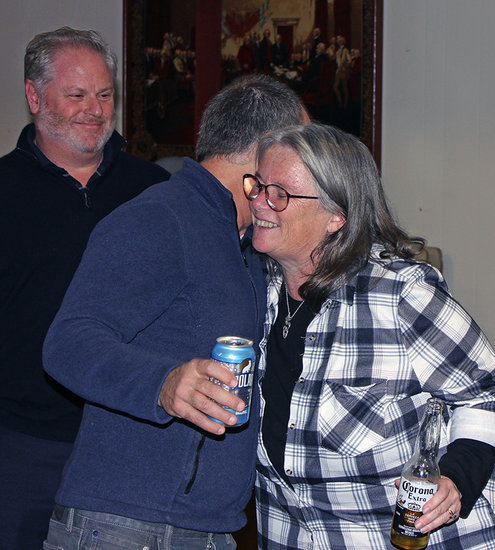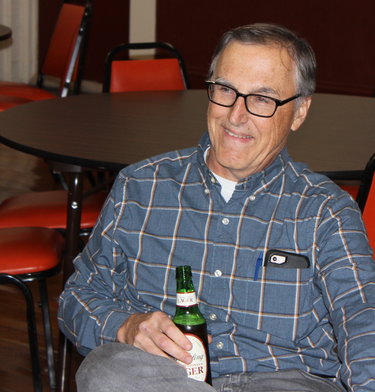Two decades of dominance: Dems take New Scotland Town Board seats
NEW SCOTLAND — The victory was tighter than in years’ past, but Democrats William Hennessy and Bridgit Burke maintained the party’s decades-long unbeaten streak in town-board elections on Tuesday.
Incumbent Hennessy was the top vote-getter with 1,474 votes, about 31 percent of ballots cast; first-time candidate and zoning-board member Burke was second with 1,268 votes, about 26 percent of the vote; Republican Timothy Stanton, in his third race for the board, had, by far, the best showing of his three runs for the board, earning 1,123 votes, about 23 percent of ballots cast; and Glenn Schultz received 935 votes, about 19.5 percent of the vote.
Small-party lines proved to be the difference in this year’s election, with the two closest candidates, Burke and Stanton, each occupying a major and minor party line. Burke received 1,149 Democratic votes and 119 votes on the Independence Party line, while Stanton received 935 Republican votes and 188 Conservative line votes.
A Republican hasn’t won a seat on the town council since 2009, when current supervisor and then-Republican, Douglas LaGrange, was re-elected. LaGrange is now a Democrat.
Since 1999, the Republican Party has won just three seats on the town board: LaGrange in 2005 and 2009, and, in 2001, Andrea Gleason, who was not enrolled as a Republican, but ran on the GOP ticket; she had been elected in 1997 as a Republican.
So, the Democrats’ structural advantage over the GOP in New Scotland makes Stanton’s showing, at the least, notable. Considering, the party’s 2015 town-board candidate received 966 fewer votes than that election’s top vote-getter and 777 fewer votes than the second-place finisher.

Next up
Hennessy, who won his third election in a row, said that he plans on working on advancing the solar project to be built on the town’s two landfills, both on Upper Flatrock Road.
A project, Hennessy said, which “is very close to fruition.”
At its October meeting, the town board passed a resolution directing its attorney and Solomon Energy to begin a lease development with General Electric Solar, a deal that will generate revenue for the town.
Hennessy said that GE Solar is close to completing a study that National Grid uses to make sure its network can absorb the electricity that would be generated by the solar development.
Water district consolidation is also something Hennessy wants to work on.
He said a consolidation would lower expenses and provide affordable service to those districts.
The town currently has nine water districts; only three have in-town sources: Clarksville, Kensington Woods, and Northeast. The village of Voorheesville supplies Colonie Country Club Estates, while the town’s remaining water districts are supplied by the town of Bethlehem.
New Scotland residents whose water is supplied by either Bethlehem or Voorheesville pay double the rate that each respective municipality’s residents pay for water.
In the Clarksville Water District, an in-town source, in 2018 for example, users had a minimum annual payment of $97.50; then the user paid $6.50 for every thousand gallons used up to 15,000 gallons, according to the town, with the price per gallon increasing as use increased.
The Feura Bush Water District is supplied by the town of Bethlehem.
In 2018, according to New Scotland, Feura Bush customers had a minimum annual payment of $235.50; users then paid $15.70 for every thousand gallons used up to 15,000 gallons.
Hennessy said a majority of town residents would probably welcome municipal water, but he said it’s just not financially feasible because New Scotland is so large and there just aren’t enough houses to justify the installation of a town-wide system.
There are certain areas where it is justifiable, he said, for example, in the northeast part of town, around the intersection of routes 155 and 85A, and then down from that intersection to Route 85.
Hennessy also wants to advance what’s been done so far with the Hilton Park and Barn. “The highway department has already cut and built trails,” he said.
There are also designs for the barn, he said, the town is just waiting to hear back from the state on the matching grant it applied for; it should hear back at sometime before the end of the year.
Since the town board is on the right track, Burke said, “a lot of it for me is learning as much as I can,” about being an effective board member.
Burke, who won the retiring Patricia Snyder’s seat, previously said that a lot of people in town talk about wanting to have a restaurant or small business, and it’s her sense is that they don’t know what’s allowed and what’s not — and how to jump those hoops.
What she wants to do is spend some time figuring out how to better publicize that message. She said that’s “something that is important” to her.
Burke doesn’t see herself as having a speciality or “lane” just yet.
The things that “really matter” to her are the environment and fiscal responsibility, she said, and those are things that the board is doing well. So, she said, where she sees she can made an immediate impact is helping to update the town’s zoning code. “As a lawyer, I think I can help with that,” she said, but she added that won’t be a “lane,” rather an area of expertise.
Burke has also done a lot of grant-writing, she said.
New Scotland has 6,611 registered voters: 38 percent are Democrats (2,578); 24 percent are Republicans (1,595); and 27 percent (1,816) are not affiliated with a party. The rest of registered voters are enrolled in small parties: 367 with the Independence Party; 210 Conservatives; 21 are registered with the Green Party; 15 with the Working Families Party; and seven are Libertarians, according to 2019 figures from the Albany County Board of Elections.
Unopposed-incumbent winners
Supervisor Douglas LaGrange won re-election with 1,963 votes; this was his third, unopposed win. There hasn’t been a competitive race for the office since 2009, when incumbent Democrat Thomas Dolin beat Republican Michael Fields. Dolin then ran unopposed in the next two elections, until he retired in 2015 and backed his former opponent from the 2007 election, LaGrange, for the position.
Clerk Diane Deschenes received 2,086 votes; she has been town clerk since 2000, when she was first elected. She ran unopposed.
Town Justice David Wukitsch received 1,980 votes. He had been appointed town justice in May 2007, and went on to win a judgeship in November of that year, subsequently earning re-election in 2011 and then again four years later.
Ken Guyer won his fourth straight unopposed election for highway superintendent with 2,046 votes. He won his first election in 2013, after long-time Highway Superintendent Darrell Duncan left the town for a job as head of Albany County Public Works in March 2012.



